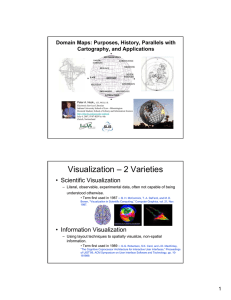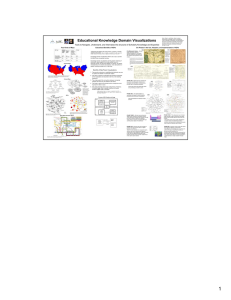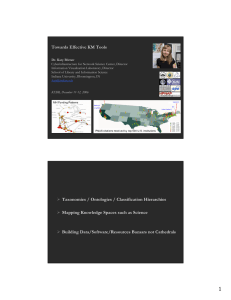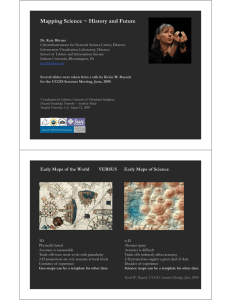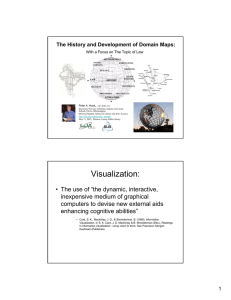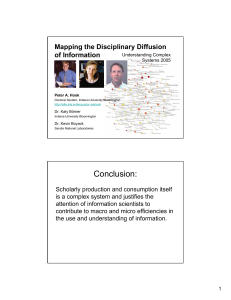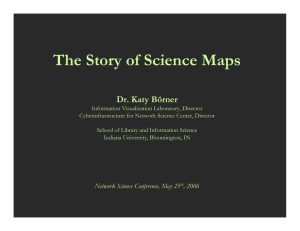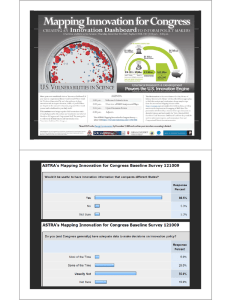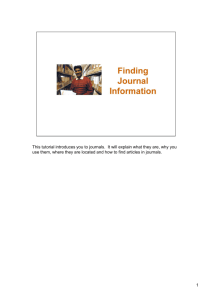Knowledge Domain Visualizations: An Emerging Field of Information Cartography
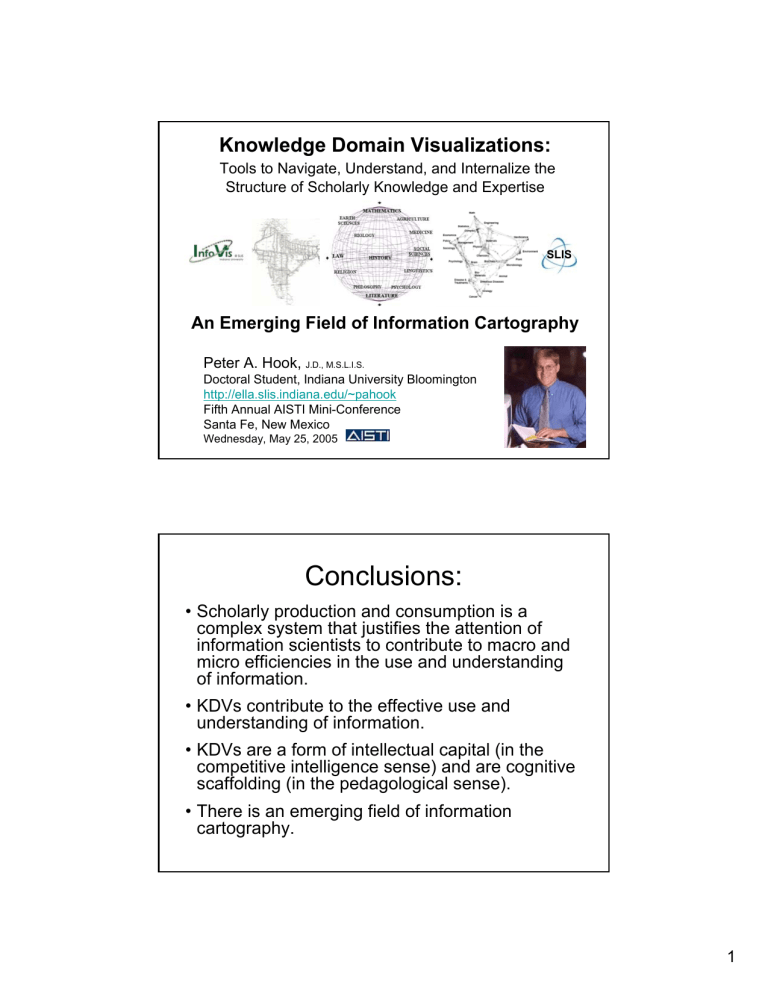
Knowledge Domain Visualizations:
Tools to Navigate, Understand, and Internalize the
Structure of Scholarly Knowledge and Expertise
SLIS
An Emerging Field of Information Cartography
Peter A. Hook,
J.D., M.S.L.I.S.
Doctoral Student, Indiana University Bloomington http://ella.slis.indiana.edu/~pahook
Fifth Annual AISTI Mini-Conference
Santa Fe, New Mexico
Wednesday, May 25, 2005
Conclusions:
• Scholarly production and consumption is a complex system that justifies the attention of information scientists to contribute to macro and micro efficiencies in the use and understanding of information.
• KDVs contribute to the effective use and understanding of information.
• KDVs are a form of intellectual capital (in the competitive intelligence sense) and are cognitive scaffolding (in the pedagological sense).
• There is an emerging field of information cartography.
1
OVERVIEW
• Introduction
• History of KDVs
• How Created
• How Used
• Educational Aspects
• Metro Map Metaphor
• Predictions
Introduction to KDVs
2
Definitions
• Knowledge domain visualizations (KDVs) are the graphic rendering of bibliometric data designed to provide a global view of a particular domain, its structural details, or its salient characteristics (most cited authors or papers, bursting concepts, etc.).
• The visualized domain may vary in size from large to small.
• all of knowledge,
• a grouping of academic subjects (science),
• a discipline (information science)
• a single book (Joyce’s Portrait of the Artist as a Young Man.
)
• KDVs are also referred to as domain maps and the process of their creation as domain mapping.
Continuums
• spatially literal spatially abstract
• hand generated produced by automated means
• primitive graphic and cartographic rich
3
2005
Map of all Science & Social Science
• Each dot is one journal
• Journals group by discipline
• Labeled by hand
• The map is comprised of
7,121 journals from year 2000.
Boyack, K.W., Klavans, R., & Börner,
K. (2005, in press). Mapping the backbone of science. Scientometrics .
LIS
Comp Sci
Geogr
Robot
PolySci
Law
Oper Res
Econ
Social Sci
Math
Comm
Sociol
Hist
Appl
Math
AI
Stat
Elect Eng Mech Eng
Geront
Educ
Psychol
Psychol
Neurol
Anthrop
Psychol
Nursing
OtoRh
Surg
Pharma
Health
Care
Sport
Sci
Radiol
Env
Gen Med
Emerg
Med Neuro
Sci
Biomed
Rehab
Cardio
Oncol
Ped
Medicine
Endocr
Hemat
Genet BioChem
Immun
Astro
Ecol
Nutr
Urol
Virol
Gastro
Plant
Ob/Gyn
Derm
Endocr
Dairy
Dentist
Pathol Food Sci
Parasit
Nuc
Physics
CondMat
Aerosp
Analyt
Chem P Chem
Elect
Chem
Gen/Org
Chemistry
GeoSci
Polymer
Chem Eng
Meteorol
Marine GeoSci
Env
Earth Sciences
Soil
Zool
MatSci
Fuels
Paleo
Constr
Agric
Ophth
Vet Med
Ento
2005
Information space of
22,000 conference abstracts submitted to the AAG annual meeting from 1993-
2002.
See: Skupin, A., and Hagelman, R. (2005) Visualizing Demographic Trajectories with Self-Organizing Maps. GeoInformatica . 9(2).
4
2004
Intersecting threads of thought of
Keith
Nesbitt’s doctoral dissertation.
Employing the metro map metaphor.
Nesbitt (2004). “Getting to more Abstract Places using the Metro Map Metaphor,” IV’04, 8 th
International Conference on Information Visualisation London,2004.
Visualization of Growing Co-Author Networks
Won 1st prize at the IEEE InfoVis Contest
(
Ke, Visvanath & Börner, 2004)
2004
5
U. Minnesota
U Berkeley
After Stuart Card, IEEE InfoVis Keynote, 2004.
PARC
Virginia Tech
Georgia Tech
Bell Labs
U Maryland
CMU
Wittenberg
Visual Encoding
• Nodes represent authors
• Edges denote coauthorship relations
• Node area size reflects the number of singleauthor and co-authored papers published in the respective time period.
• Node color indicates the cumulative number of citations received by an author.
• Edge color reflects the year in which the coauthorship was started.
• Edge width corresponds to the impact weight.
Börner, Katy, Dall’Asta, Luca, Ke,
Weimao and Vespignani, Alessandro.
(April 2005) Studying the Emerging
Global Brain: Analyzing and Visualizing the Impact of Co-Authorship Teams.
Complexity , special issue on
Understanding Complex Systems .
74-84
74-04
74-94
2005
6
Benefits of Co-Authoring
Publication strength S p and the citation strength S c of authors versus the degree of authors (number of co-authors) for the 74-04 time slice.
Solid lines are a guide to the eye indicating the presence of two different regimes as a function of the co-authorship degree k .
Discussion:
Two definite slopes.
Impact and productivity grow faster for authors with a large number of co-authorships.
The three high degree nodes represent S._K._Card,
J._D._Mackinlay, and
B._Shneiderman.
2005
Spatio-Temporal Information Production and Consumption in the U.S.
• Dataset: all PNAS papers from 1982-2001
(dominated by research in biology)
• 47K papers, 19K unique authors, 3K institutions
• Each paper was assigned the zip code location of its first author
• Dataset was parsed to determine the 500 top cited (most qualitatively productive) institutions.
• Harvard University (13,763 citations)
• MIT (5,261 citations)
• Johns Hopkins (4,848 citations)
• Stanford (4,546 citations)
• University of California San
Francisco (4,471 citations)
• All totals exclude self citation
Börner, Katy & Penumarthy, Shashikant. (in press) Spatio-Temporal Information
Production and Consumption of Major U.S. Research Institutions. Accepted at the
10th International Conference of the International Society for Scientometrics and
Informetrics, Stockholm, Sweden, July 24-28.
g82-86 = 1.94 (R2=91.5%) g87-91 = 2.11 (R2=93.5%) g92-96 = 2.01 (R2=90.8%) g97-01 = 2.01 (R2=90.7%) g = gamma
7
Relevant Metrics
• References = institution cites other institutions (Consumes Information)
•
Citations
= institution is cited by other institutions (Produces Information (of utility))
• Methodology can determine the net producers and consumers of information.
8
Co-Occurrence of West Topics in
Supreme Court Cases
2004
While grouped in different
West categories (blue =
Crimes, green =
Remedies), it appears that
Criminal Law more closely relates to some Remedies topics than Crimes topics.
Color Code:
1. Persons
2. Property
3. Contracts
4. Torts
5. Crimes
6. Remedies
7. Government
Node Size
~ Number of times topic appears in the dataset
Node Color
~ West Category
History of KDVs
9
1794
Map of the Various
Paths of Life ,
Benjamin Johnson,
Philadelphia, 1805, originally published as a jigsaw puzzle in 1794, Map
Collection, Yale
University Library.
From: Harmon,
Katherine (2004). You
Are Here: Personal
Geographies and
Other Maps of the
Imagination. New
York: Princeton
Architectural Press.
1939
John D. Bernal was a world renowned physicist, a historian of science, and a sociologist of science. He is considered to have produced one of the first ‘maps’ of science.
Bernal, J.D. (1939). The Social Function of Science.
London: Routledge & Kegan Ltd.
10
1988
Shwerwood, M. & Sutton, C. (Eds). (1988). The Physical World . New York:
Oxford University Press.
Descriptive Æ Scientific Cartography
Prior to the 1600’s cartography was merely descriptive. Advances in calculating location on the planet made it scientific.
– Triangulation over large distances from a known base measure.
– Using the moons of Jupiter to establish longitude on land.
– Using accurate time pieces to establish longitude at sea.
– Looking below above and below the surface.
– Accurately measuring depth and altitude, and representing them on maps.
The same is now occurring with domain maps.
– We have had descriptive maps for a long time.
– Now they are becoming methodologically rigorous.
– They are becoming scientific.
– This is the involvement of information science and the emerging field of information cartography.
Headrick, Daniel R.
(2000). When
Information Came of
Age: Technologies of Knowledge in the
Age of Reason and
Revolution, 1700-
1850. New York:
Oxford University
Press.
11
1744
• Rigorous, methodical
(scientific) cartography.
• The mapping of France by triangulation.
• César-Francois Cassini de Thury
Headrick, Daniel R. (2000).
When Information Came of
Age: Technologies of
Knowledge in the Age of
Reason and Revolution,
1700-1850. New York: Oxford
University Press.
1870
• The mapping of
India by triangulation.
• Captain George
Everest
Morrison, Philip and Phylis (1987).
The Ring of Truth.
New York:
Random House.
12
1696
• First Accurate Map of the Earth
• 40 points of accurate longitude
• Based on
Moons of
Jupiter to compare with local time in
Paris.
• Cassini.
Morrison, Philip and Phylis (1987).
The Ring of Truth.
New York:
Random House.
1 st Otlet and then De Solla Price
Contemplate Domain Maps
1895 – Paul Otlet realizes that Melvil Dewey’s Decimal
Classification could be used to map knowledge domains. Begins work on converting Dewey’s system into the more faceted
Universal Decimal Classification (UDC).
1918 – Otlet states again that the UDC may be used to create “an immense map of the domains of knowledge” (Otlet, 1918, p. 78).
Rayword, B. (1994). Visions of Xanadu: Paul Otlet (1868-1944) and hypertext. JASIS, 45(4), 235-250.
1965 –
Derek De Solla Price
- published contemplation of using bibliometric techniques to create maps of scientific literatures.
De Solla Price, Derek J. (1965). Networks of Scientific Papers
Science , New Series, Vol. 149, No. 3683. (Jul. 30, 1965), pp. 510-
515.
1895
13
Historiograph of
DNA Development
(Garfield, Sher, & Torpie, 1964)
" The Use of Citation Data in
Writing the History of Science.
"
Published by The Institute for
Scientific Information, December
1964. Report of research for Air
Force Office of Scientific
Research under contract
F49(638)-1256.
Eugene Garfield
, recent photo.
Creator of the ISI
Web of Science citation database. http://www.garfield.library.upenn.edu/
Co – Discoveries / Implementation
Using Co-Citation to create domain maps.
• Small, H. (1973). Co-citation in the scientific literature: A new measure of the relationship between two documents. JASIS, 24, 265-269.
• Marshakova, I.V. (1973). A system of document connections based on references. Scientific and Technical
Information Serial of VINITI, 6, 3-8.
1964
1973
14
1981
Institute for Scientific
Information. (1981). ISI atlas of science: Biochemistry and molecular biology, 1978/80 ,
Institute for Scientific
Information, Philadelphia,
PA.
1981
Institute for Scientific
Information. (1981). ISI atlas of science: Biochemistry and molecular biology, 1978/80 ,
Institute for Scientific
Information, Philadelphia,
PA.
15
White, Howard & McCain, Katherine. (
1998
). Visualizing a
Discipline: An Author Co-citation Analysis of Information Science,
1972-1995, J. Am. Soc. Information Science, 49:4, 327-356.
• IS Dichotomy – Analysts (Bibliometricians) & Retrievalists
• Domain Mapping is a form of Artificial Intelligence
1998
16
FIG. 2.
Top 100 authors in information science, 1972–1979.
FIG. 3.
Top 100 authors in information science, 1980–1987.
17
FIG. 4.
Top 100 authors in information science, 1988–1995.
FIG. 5.
Shifts in 19 authors’ citation images.
18
FIG. 6.
INDSCAL map of 75 ‘‘canonical’’ information science authors.
FIG. 7. Changes in importance of axes over three periods.
19
Small, H. (
1999
). Visualizing Science by Citation Mapping, J. Am.
Soc. Information Science, 50:9, 799-813.
1999
1985
FIG. 1.
An early co-citation map of science showing the major disciplines of the natural sciences: Biology, chemistry, and physics. The data are from a fivelevel co-citation analysis. Multidimensional scaling was used to position macroclusters (from: Small & Garfield, 1985).
20
1999
FIG. 3
. The map is a two-dimensional computer visualization of 36,720 documents comprising a multidisciplinary sample selected by a fractional citation counting method, covering the years 1981–1995. The circles represent 35 fourth-level clusters, whose internal structure can be explored by zooming into the object. The configuration of thirdlevel clusters is also visible within each fourth-level object. The sizes of the circles reflect the spread of lower level objects contained. Lines represent strong co-citation links among the clusters. Subject matter ranges from social science on the lower right to physical science on the left. Labels are based on a frequency analysis of article titles and journal category names.
1999
FIG. 4.
A detailed view of the large biology circle at the center of Figure 3, showing the level-three clusters within it as well as the level-two objects within each level three cluster. Topics range from immunology to neuroscience.
21
1999
FIG. 5.
A detailed view of the level-three cancer genetics cluster on Figure 4, showing the level-two objects contained as well as the level-one objects within them. Clusters dealing with various forms of cancer are arranged around the central cluster on the p53 tumor suppressor protein.
1999
FIG. 6.
A detailed view of a group of first-level clusters whose location on Figure 5 is indicated by an arrow within the p53 tumor-suppressor region. The largest level-one cluster is on the p21 protein containing 39 documents. Documents more than two years older than the base year, 1995, are shaded. Unshaded documents are from the two most recent years, 1994 and 1995, making this a “hot” cluster.
22
How KDVs Are Created
Process Flow for Visualizing KDs
Börner, K., Chen, C., & Boyack, K.W. (2003). Visualizing Knowledge Domains. In Annual Review of
Information Science and Technology , 37 (B. Cronin, ed.), Information Today, Medford, NJ, pp. 179-255.
23
Process Used by Boyack
Records from
Digital
Library
Browsable MAP
Similarities between records
Correlation matrix
.6
1
.6
2
5
.1
.9
.8
6
.6
.7
3
.2
4
Dimension Reduction
Common index values such as Cosine
N ij
/ sqrt(N i
N j
)
VxOrd
VxInsight
VxOrd: Ordination Algorithm
• Force-directed placement
– Each object tries to minimize an energy equation using a solution space exploration algorithm n
E x , y
=
⎢⎣ i
=
0
( w i l i
2
⎤
⎥⎦
)
+
D
= number of edges connected to node x , y w i
=
weight of edge i l i
= euclidean length of edge i
D x,y
= density of objects at/near coordinate x,y
24
VxInsight – Knowledge Visualization
• Displays graph structures using an intuitive terrain metaphor or as scatterplot
• Enables analysts to navigate and explore graph structures at multiple levels of detail through drill-down
• Can show multiple types of associations or linkages
Strategy
• Develop and validate process, methods, and algorithms at small scale (~10k objects)
– Macro-model
– Using ISI citation data, create disciplinary maps of science using journals (~7000 titles)
– Validate using the known journal categorization structure
• Employ validated process, methods, and algorithms at larger scale
(~1M objects)
– Micro-model
– Create paper-level (~1M annually) maps of science from ISI citation data
– Validate detailed maps at local structural levels where possible
– Calculate indicators and metrics at the cluster or community level
25
Macro-model Process
• Identify individual journals
• Calculate similarity between journals from inter-citation data and co-citation data
Records from
Digital
Library
Browsable MAP
• Use VxOrd to determine coordinates for each journal
• Generate cluster assignments (kmeans) Inter-citation
1 cites 2
• Validate against ISI journal category assignments
1
Similarities between records
3
Correlation matrix
1
.6
2
.6
5
.1
.9
.7
3
4
.2
.8
6
.6
Ordination
Co-citation
1 and 2 are co-cited
2 1 2
Algorithms – Similarity Measures
Boyack, K.W., Klavans, R., & Börner, K., (2005, in press). Mapping the backbone of science.
Scientometrics .
26
Macro-model: Local Accuracy
• For each similarity measure, journal pairs were assigned a 1/0 binary score if they were IN/OUT of the same
ISI category
• Accuracy vs. coverage curves were generated for each similarity measure
• For each similarity measure, distances (in the VxOrd layouts) between journal pairs were calculated
• Accuracy vs. coverage curves were generated for each re-estimated
(distance) similarity measure
• Results after running through VxOrd were more accurate than the raw measures
• Inter-citation measures are best
1.00
0.80
0.60
0.40
0.0
0.90
0.80
0.70
0.60
0.0
IC-Cosine
IC-K50
IC-Jaccard
IC-RFavg
IC-Pearson
CC-Cosine
CC-K50
CC-Pearson
0.2
Similarity measures
FIG5_DAT.PDW
0.4
0.6
Coverage (fraction of journals)
0.8
IC-Cosine
IC-K50
IC-Jaccard
IC-RFavg
IC-Pearson
CC-Cosine
CC-K50
CC-Pearson
0.2
0.85
0.80
0.75
0.70
0.90
0.95
0.4
0.6
Coverage (fraction of journals)
1.00
0.8
1.0
1.0
Klavans, R., & Boyack, K.W. (2005, in press). Identifying a better measure of relatedness for mapping science. Journal of the American Society for Information Science and Technology .
Macro-model: Different Similarity Metrics
• ISI file year 2000, SCIE and
SSCI
• Ten different similarity metrics
– 6 Inter-citation (raw counts, cosine, modified cosine,
Jaccard, RF, Pearson)
– 4 Co-citation (raw counts, cosine, modified cosine,
Pearson)
• Inter-citation gives structure based on current citing patterns
• Co-citation gives structure based on how science is currently used
27
Macro-model: Regional Accuracy
• For each similarity measure, the
VxOrd layout was subjected to kmeans clustering using different numbers of clusters
• Resulting cluster/category memberships were compared to actual category memberships using entropy/mutual information method
• Increasing Z-score indicates increasing distance from a random solution
400
380
360
340
320
300
280
100 150 200
Number of k-means clusters
IC Raw
IC Cosine
IC Jaccard
IC Pearson
IC RFavg
CC Raw
CC K50
CC Pearson
250
• Most similarity measures are within several percent of each other
Boyack, K.W., Klavans, R., & Börner, K., (2005, in press). Mapping the backbone of science.
Scientometrics .
Computing Mutual Information
• Use method of Gibbons and Roth (Genome Research v. 12, pp. 1574-1581,
2002)
• K-means clustering (MATLAB) for each graph layout
– 8 different similarity measures
– 3 different k-means runs at 100, 125, 150, 175, 200, 225, 250 clusters
• Quality metric (mutual information) calculated as
– MI(X,Y) = H(X) + H(Y) – H(X,Y)
– where H = -
∑
Pi log2 Pi
– Pi are the probabilities of each [cluster, category] combination
– X (known ISI category assignments), Y (k-means cluster assignments)
• Z-score (indicates distance from randomness, Z=0=random)
– Z = (MIreal – MIrandom)/ Srandom
– MIrandom and Srandom vary with number of clusters, calculated from
5000 random solutions
28
Macro-model: “Best” Map
• Each dot is one journal
• Journals group by discipline
• Labeled by hand
• Generated using the IC-
Jaccard similarity measure.
• The map is comprised of 7,121 journals from year 2000.
• Large font size labels identify major areas of science.
• Small labels denote the disciplinary topics of nearby large clusters of journals.
Boyack, K.W., Klavans, R., & Börner,
K. (2005, in press). Mapping the backbone of science. Scientometrics .
LIS
Comp Sci
Geogr
Robot
PolySci
Law
Oper Res
Econ
Social Sci
Math
Comm
Sociol
Hist
Appl
Math
AI
Stat
Elect Eng Mech Eng
Geront
Educ
Psychol
Psychol
Neurol
Anthrop
Psychol
Nursing
OtoRh
Surg
Pharma
Health
Care
Sport
Sci
Radiol
Env
Gen Med
Emerg
Med Neuro
Sci
Biomed
Rehab
Cardio
Oncol
Ped
Medicine
Endocr
Hemat
Genet BioChem
Immun
Astro
Ecol
Nutr
Urol
Virol
Gastro
Plant
Ob/Gyn
Derm
Endocr
Dairy
Dentist
Pathol Food Sci
Parasit
Nuc
Physics
CondMat
Aerosp
Analyt
Chem P Chem
Elect
Chem
Gen/Org
Chemistry
GeoSci
Polymer
Chem Eng
Meteorol
Marine GeoSci
Env
Earth Sciences
Soil
Zool
MatSci
Fuels
Paleo
Constr
Agric
Ophth
Vet Med
Ento
Macro-model: Structural Map
• Clusters of journals denote 212 disciplines
(7000 journals).
• Labeled with their dominant ISI category names.
• Circle sizes (area) denote the number of journals in each cluster.
• Circle color depicts the independence of each cluster, with darker colors depicting greater independence.
• Lines denote strongest relationships between disciplines (citing cluster gives more than 7.5% of its total citations to the cited cluster).
• Enables disciplinary diffusion studies.
• Enables comparison of institutions by discipline.
Boyack, K.W., Klavans, R., & Börner, K. (2005, in press). Mapping the backbone of science.
Scientometrics .
29
Macro-model: Detail
• Clusters of journals denote disciplines
• Lines denote strongest relationships between journals
Boyack, K.W., Klavans, R., &
Börner, K. (2005, in press).
Mapping the backbone of science. Scientometrics .
30
What Comes Next?
(1) Further Refinements
(2) Different Visualizations
(3) Time series to capture the evolution of disciplines
(4) Larger Datasets –
Incorporation of patent and grant funding data
(5) A new era in information cartography
(6) Widespread educational uses of knowledge domain maps.
Uses combined SCIE/SSCI data from 2002.
http://vw.indiana.edu/aag05/slides/boyack.pdf
How KDVs Are Used
31
Process of KDV Creation and Usage
Creation
Domain
Characteristics
(Citation Networks,
Coauthor Networks,
Topic Co-occurrence, etc.)
Domain Cartography
(Production of the
Domain Map)
Domain
Map
(Physical
Object)
Visual
Perception
(Domain map viewed by user)
Cognitive
Understanding
(Content integrated with user’s previous knowledge)
Use
Domain Visualizations Are Used For …
Fields and paradigms
Authors
Documents
Field structure, dynamics, paradigm development
Communities and networks
Social structure, intellectual structure, some dynamics
Research performance or competitive advantage
Use network characteristics as indicators
Use field mapping with indicators
Commonly used algorithms
Social network packages,
MDS, factor analysis,
Pathfinder networks
Co-citation, co-term, vector space, LSA, PCA, various clustering methods
Journals
Science structure, dynamics, classification, diffusion between fields
Words
Cognitive structure, dynamics
Vector space, LSA, LDA
(20)
Indicators and metrics
Comparisons of fields, institutions, countries, etc., input-output
Counts, correlations
Boyack, K.W. (2004). Mapping Knowledge Domains: Characterizing PNAS. Proceedings of the
National Academy of Sciences of the US , 101(S1), 5192-5199.
32
Aside: Citation Mapping Comes of Age
• PNAS online interface now generates a citation map for some of its articles.
Boyack, K.W. (2004). Mapping Knowledge Domains: Characterizing PNAS. Proceedings of the
National Academy of Sciences of the US , 101(S1), 5192-5199.
Boyack, K.W. (2004). Mapping Knowledge Domains: Characterizing PNAS. Proceedings of the
National Academy of Sciences of the US , 101(S1), 5192-5199.
Goals of Sandia Science Mapping Project
• Create maps of science with indicators of innovation, risk, and impact at the research community level
• Enable better R&D through:
– Identification and evaluation of current work in a global context
– Identification of highly-ranked communities in areas related to current work
– Identification and evaluation of proposed work in a global context
– Identification of research entry points (or potential collaborators) and emerging applications in our areas of focus
– Identification of opportunity and vulnerability using institutional comparisons
– Better understanding of the innovation process and better anticipation of future trends(?)
33
http://vw.indiana.edu/aag05/slides/boyack.pdf
Educational Aspects of KDVs
34
Bridging the Practices of Two
Communities
• Domain Maps are widely used in the field of education.
• Called Concept Maps.
(Also called: mind maps, pattern notes, brain patterns, spider maps, networks, semantic maps, semantic networks, and semantic webs.)
• Differ from domain maps produced by information scientists as to scale and method of production.
• Each community has something to offer the other.
Current Practice in Education
• “[L]earning best begins with a big picture, a schema, a holistic cognitive structure, which should be included in the lesson material[.]”
• “[T]he designers’ task is to develop a big picture and emphasize it[.]
(West et al., (1991).
Instructional Design: Implications from Cognitive Science. Englewood Cliffs, New
Jersey: Prentice Hall, p. 58).”
• This is done with concept maps.
35
Benefits of the Big Picture
• Provides a structure or scaffolding that students may use to organize the details of a particular subject.
• Information is better assimilated with the student’s existing knowledge.
• Visualization enhances recall.
• Makes explicit the connections between conceptual subparts and how they are related to the whole.
• Helps to signal to the student which concepts are most important to learn.
Dual Coding Theory of Memory
• Humans store textual and visual information in different areas of the brain.
(Paivio, 1987; Kulhavey & Stock, 1994).
• Visual/spatial images trigger memory of textual elements, and text triggers memory of images and locations.
36
Semantic Network Theory of Learning
• Human memory is organized into networks consisting of interlinked nodes.
• Nodes are concepts or individual words.
• The interlinking of nodes forms knowledge structures or schemas.
• Learning is the process of building new knowledge structures by acquiring new nodes.
• When learners form links between new and existing knowledge, the new knowledge is integrated and comprehended.
GRADES 6-8
Feather, Ralph M. Jr., Snyder, Susan
Leach & Hesser, Dale T. (1993). Concept
Mapping, workbook to accompany, Merrill
Earth Science. Lake Forest, Illinois:
Glencoe.
37
Concept Map Produced by Cmap Tools
Created by Joseph Novak and rendered with CMapTools. http://cmap.ihmc.us/
Concept Map Created With Rigor
Benefits of Computer-
Based Collaborative
Learning Environments
Kealy, William A. (2001). Knowledge
Maps and Their Use in Computer-
Based Collaborative Learning
Environments. Journal of
Educational Computing Research.
25(4) 325-349.
38
Sherwood, Martin & Sutton, Christine, eds. (1988). The Physical World. New York: Oxford University Press.
Elements of Concept Maps
(1) shapes or nodes
--representing core elements of a concept
(2) connectors or links between the shapes or nodes
(3) connecting words --that describe how two nodes are related, and
(4) patterns
--such as a hierarchical or circular ordering of the nodes
39
Education → KDVis
• Educational community places more emphasis on explicit connections between nodes and labels for the type of connection.
• Use of action phrases such as “gives rise to,” and “causes.”
• Explicitly labeled connections, linkages, or notion of causality are largely missing from
KDVs.
• Also often missing are clearly defined, bounded regions for cognitive chunking and assimilation.
KDVis → Education
• Automated techniques for data harvesting, data processing, and information visualization.
• Larger scale, really ‘Big Picture,’ domain maps (all of science).
• Can market our contribution as concept maps, an educational tool with which educators are already familiar .
40
Modified from Boyack et al. by Ian Aliman, IU
Domain Map Substrate (Contracts Law)
41
Metro Map Metaphor
Spatial Representations of Domains
Composed of Two Parts:
– Spatial Substrate
– Thematic Overlay
True for:
– Thematic Maps
(cartography)
– Concept Maps
(education, psychology, wayfinding)
– KDVs
(information science)
– Metro Map Metaphor Information Spaces
(information science)
42
Thematic Map Concept Map
Gastner, Michael, Shalizi, Cosma, & Newman, Mark (2004).
KDVis
Feather, Ralph M. Jr., Snyder, Susan Leach & Hesser, Dale T. (1993). Concept
Mapping, workbook to accompany, Merrill Earth Science. Lake Forest, Illinois: Glencoe.
Metro Map Metaphor
Boyack, Kevin W., Mane, Ketan K. and Börner, Katy. (2004). Mapping Medline Papers, Genes, and Proteins Related to Melanoma Research. IV2004 Conference, London, UK, pp. 965-971 Nesbitt, Keith V. (2004). Getting to more Abstract Places using the Metro Map Metaphor. (IV’04).
IEEE.
Comparison of the Spatial
Representations of Information
43
Iconographic Substrates
• Information space superimposed onto actual and familiar spaces.
• Analogous to the memory palace device for facilitating recall.
• Associations with the actual place can amplify the meaning of the information space and heighten memory.
44
DC BLOGS http://www.reenhead.com/map/metroblogmap.html
2004
Intersecting threads of thought of
Keith
Nesbitt’s doctoral dissertation.
Employing the metro map metaphor.
Nesbitt (2004). “Getting to more Abstract Places using the Metro Map Metaphor,” IV’04, 8 th
International Conference on Information Visualisation London,2004.
45
Popularity of Metro Map Metaphor
• Explicit Linkages – Does not rely on the distance similarity metaphor.
• Highlights connectivity
• Familiar device to many people.
• Beck – Abstracted the information space from reality.
• Modern trend – Impose abstraction on reality.
Predictions
46
Six Phases
• in the use, adoption, and implementation of KDVs.
• The first two have already occurred.
• The remaining four are prospective— compelled by the cognitive benefits of
KDVs.
Hook, Peter A. and Börner, Katy. (in press) Educational
Knowledge Domain Visualizations: Tools to Navigate,
Understand, and Internalize the Structure of Scholarly
Knowledge and Expertise. In Amanda Spink and Charles
Cole (eds.) New Directions in Cognitive Information
Retrieval. Springer-Verlag. http://ella.slis.indiana.edu/~pahook/product/05-educkdvis.pdf
Phases 1 & 2
(1) Bibliometricians realized that they could use bibliographic datasets and techniques such as author co-occurrence to provide maps of a particular discipline.
– These early maps were graphically simple and painstakingly created by hand.
(2) The implementation of automated techniques for data harvesting, processing, and information visualization.
– This has facilitated the mapping of larger domains.
47
Phases 3 & 4
(3) Domain maps will become widely known outside of information Science.
– BBC Article --
Whitehouse, D. (2004). Scientists Seek 'Map of Science.
' BBC News.
Wednesday, 7 April, 2004. Available at: http://news.bbc.co.uk/1/hi/sci/tech/3608385.stm
– They will become popular with educators and will be used to enhance classroom pedagogy.
– They will be as common as regular wall maps and the periodic table of the elements.
(4)
The widespread use of domain maps will lead to steps to harmonize and better preserve the scholarly data from which they are created.
– This might include unique author identification numbers,
– better and standardized citation practices,
– and repositories containing information such as all of the sources cited in books.
Phases 5 & 6
(5) Domain maps will routinely be used as one of the access options to digital libraries and (OPAC’s).
– Even if a user chooses to do a keyword search, domain maps will be dynamically displayed unobtrusively in the background, subtly conveying to the user the intellectual landscape of the particular domain and the specific neighborhood of the user’s search interest.
(6) Dynamic domain maps will capture and portray the diffusion of information.
– This diffusion of knowledge may occur from one author to the next, one journal to another, or among scientific disciplines, etc.
– Domain maps will have predictive elements that will forecast and model the spread of knowledge.
– They will be used widely for science forecasts in a similar fashion as today’s weather forecast maps.
48
The End
Slides Available:
• http://ella.slis.indiana.edu/~pahook
Special thanks to:
Katy Börner Kevin Boyack
49
